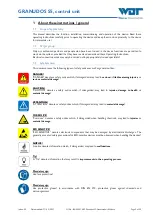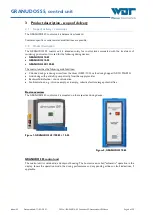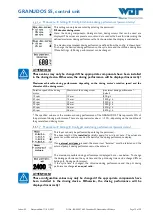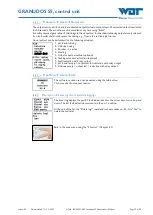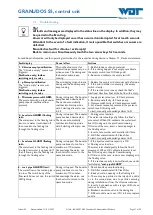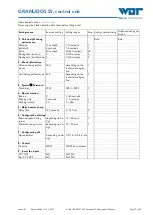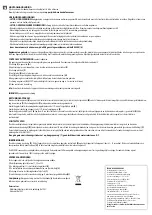
GRANUDOS S5, control unit
Index: 02
Date modified: 11/05/2021
OI No.: BA SW 014-02 Granudos S5-Steuereinheit EN.docx
Page 12 of 29
Explanation of the setting parameters
Chlorine:
Dosing time for chlorine granulate in seconds per cycle, can be set from
1-15 sec. The dosing performance set in this way can be seen on the start screen. It is
best to use the “shortcut”, see Chapter 6.1.
pH (acid):
Dosing time for acid in seconds / cycle, can be set from 1-8 sec.
Cycle:
Length of entire dosing cycle in seconds, can be set from 30-360 sec.
The cycle time
must be set first
. If the cycle time is changed, the dosing performance
for chlorine and acid changes
at an equal ratio
.
Dos-limit Cl:
Dosing time monitoring for the chlorine dosing with external control,
can be set in minutes from 0-100 min. This prevents overdosing in case of a fault in
the control:
For an explanation, see 6.3.1.8
Dos-limit pH:
Dosing time monitoring for the acid dosing with external control in
minutes from 0-100 min. – see dosing time limit for chlorine.
Explanation of dosing time monitoring “Dos-limit Cl/pH”
If the GRANUDOS is controlled by a measuring and control device, the dosing performance must be set
sufficiently high so that even large loads can be regulated without significant deviations from the target value.
In case of a pulse width modulation (PWM), this means that the pause times must always be greater than the
dosing times, since the actual values should approach the target values. However, if the dosing times are
longer than the pause times, then either the dosing performance is too low (set too weakly, or motor or
screw are defective), or there is a malfunction in the measuring and control device (control relay stuck, contact
defective) or a fault in the Granudos control board.
The dosing time monitoring totals the dosing times against the pause times, and if the set dosing time limit is
exceeded, dosing is deactivated and indicated as a fault.
Both the chlorine and pH control and/or dosing are monitored.
Example for calculating the realisable dosing performance required according to DIN 19643.
According to DIN 19643, a dosing performance of 2g chlorine per 1m³/h circulation capacity must be
possible in indoor pools. In outdoor pools, a dosing capacity of 10 g/m³h is required as a possible dosing
performance.
Calculation: Thus, for an indoor pool with 600 m³ and a circulation capacity of 200m³/h, a dosing
performance of 200 m³/h x 2g chlorine =
400g/hour
must be possible.
In the delivery state, the maximum dosing performance of the GRANUDOS is displayed in the operating
menu according to the installed dosing technology. (see also Chapter 6.5.1.5 config. Cl / pH)
Example for setting the dosing performance
1. Chlorine dosing
In an indoor pool
, the usual chlorine requirement is around 200-300 g/100 m3 water content per day. For
a 600 m
3
pool, this equals 250 x 6 = 1500 g/day or
150 g/hour
with 10 hours of circulation time. If the
GRANUDOS is designed with a dosing technology of
1600 g/h
– see “Config Cl”, about
150 g/h
should be
set with continuous dosing without measuring and control technology. To do so, the cycle could be reduced
to 60 seconds and the dosing time could be reduced so that the start screen (see above) displays approx.
150
g/h
If a measuring and control technology is present
, the dosing performance must be set about 2-3x as high
to be able to control demand peaks. In this case, a dosing performance of
300-400 g/h
would be required.
Set the cycle to 30 seconds here and reduce the dosing time until about
350 g/h
is displayed.
In an outdoor pool,
with fair weather the chlorine consumption is about
5x as high
, i.e., in the above pool,
a dosing performance of approx.
700-800 g/h
should be provided. With the assumed incorporated dosing
performance of
1600 g/h
, the cycle should therefore be set to 30 seconds, and the dosing performance
should be set to the desired value.
After a few days, a readjustment may be necessary, according to the obtained measuring results –
measuring value deviations from the target value!
2. Acid dosing
No exact prediction can be made for acid consumption. The actual demand for chemicals depends on the
concentration of the acid, frequency of use by pool visitors and the specific local conditions (fresh water pH,
hardness, temperature) and must be readjusted according to the measuring values:
At the start, the acid dosing is adjusted to approximately half of the chlorine dosing; e.g., if chlorine is 600g/h,
then set acid to approx. 300ml/h. (With 37% sulphuric acid).



